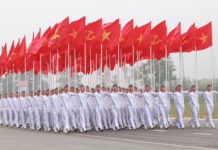In spite of the extensive efforts made by local archaeologists, historians, and experts over the past decade, no progress has been made in restoring the main palace of the Thang Long Imperial Citadel.

On August 1, 2010, the Thang Long Imperial Citadel was officially recognized as a world cultural heritage site by the World Heritage Committee.
An unexpected discovery ten years ago finally proved the existence and splendor of the Thang Long Imperial Citadel. Prior to 2002, the site was an abandoned area occupied by military units. It was during the construction of new buildings on the land that important archaeological sites were uncovered, marking a significant breakthrough in proving the existence of the ancient citadel.
Since then, extensive excavations have revealed a treasure trove of relics dating back over 1,300 years, covering various dynasties in Vietnamese history. The Thang Long Imperial Citadel has been preserved, opened to the public, and recognized as a cultural heritage site by UNESCO in 2010.
.jpg)
Efforts to explore and preserve the Thang Long Imperial Citadel continue, with annual excavations being conducted to uncover more hidden cultural treasures. In November 2020, an international seminar was held to evaluate the archaeological excavation and conservation efforts of the imperial citadel.
The Thang Long Imperial Citadel was the witness to numerous historical events and dynasties over a thousand years. Although many works of art and architecture were destroyed during wars, traces of the citadel still remain. Despite a third of the area being unearthed, there are still secrets waiting to be discovered beneath the surface.

One of the most significant architectural structures within the Thang Long Imperial Citadel is the Kinh Thien Palace. Built in the 15th century, it served as a venue for important royal ceremonies and state affairs. However, the palace was destroyed and its exact location and architecture remain unknown.
Over the past decade, Vietnamese scientists and archaeologists have conducted extensive research on the Kinh Thien Palace in order to reconstruct this important historical site. However, the restoration work has not yet commenced, leaving many unanswered questions for local scientists.



